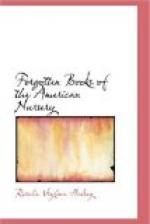The denominational stories produced by the several Sunday-school societies were, as has been said, only a kind of scaffolding upon which to build the teachings of the various churches. But their sale was enormous, and a factor to be reckoned with because of their influence upon the educational and moral tales of their period. By eighteen hundred and twenty-seven, fifty-thousand books and tracts had been sent out by one Sunday-school society alone.[204-A] There are few things more remarkable in the history of juvenile literature than the growth of the business of the American Sunday School Union. By eighteen hundred and twenty-eight it had issued over seven hundred of these religious trifles, varying from a sixteen-page duodecimo to a small octavo volume; and most of these appear to have been written by Americans trying their inexperienced pens upon a form of literature not then recognized as difficult. The influence of such a flood of tiny books could hardly have been other than morbid, although occasionally there floated down the stream duodecimos which were grasped by little readers with eagerness. Such volumes, one reader of bygone Sunday-school books tells us, glimmered from the dark depths of death and prison scenes, and were passed along with whispered recommendation until their well-worn covers attracted the eye of the teacher, and were quickly found to be missing from library shelves. Others were commended in their stead, such as described the city boy showing the country cousin the town sights, with most edifying conversation as to their history; or, again, amusement of a light and alluring character was presumably to be found in the story of a little maid who sat upon a footstool at her mother’s knee, and while she hemmed the four sides of a handkerchief, listened to the account of missionary enterprises in the dark corners of the earth.
To us of to-day the small illustrations are perhaps the most interesting feature, preserving as they do children’s occupations and costumes. In one book we see quaintly frocked and pantaletted girls and much buttoned boys in Sunday-school. In another, entitled “Election Day,” are pictured two little lads watching, from the square in front of Independence Hall, the handing in of votes for the President through a window of the famous building—a picture that emphasizes the change in methods of casting the ballot since eighteen hundred and twenty-eight.
That engravers were not always successful when called upon to embellish the pages of the Sunday-school books, many of them easily prove. That the designers of woodcuts were sometimes lacking in imagination when obliged to depict Bible verses can have no better example than the favorite vignette on title-pages portraying “My soul doth magnify the Lord” as a man with a magnifying glass held over a blank space. Perhaps equal in lack of imagination was the often repeated frontispiece of “Mercy streaming from the Cross,” illustrated by a large cross with an effulgent rain beating upon the luxuriant tresses of a languishing lady. There were many pictures but little art in the old-fashioned Sunday-school library books.




